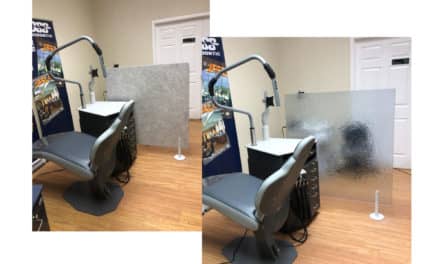by Jackie Dorst and Leslie Canham
Preparing your reception room for flu season
Is the most infectious room in your orthodontic office—the reception room—overlooked when it comes to infection control? When a patient comes to your orthodontic practice for an appointment, many times the patient’s mom, dad, or siblings come too. To keep siblings busy during the visit, most offices have a play area with toys, computers, games, and books. As the day progresses, kids from different families play together, laughing, sneezing, coughing, and touching toys and other inanimate surfaces. Occasionally, some of these visitors are sick. It is part of your job to attempt to prevent the transmission of all respiratory infections, including influenza (flu), in the public areas of the orthodontic office, just as you do in the clinical areas.
A Few Flu Facts
Flu is spread from infected persons by the transfer of microbial-laden secretions in respiratory droplets. Depending on the viral load within the droplets, infectious concentrations of influenza viruses can survive evaporation of the respiratory particles and remain suspended in the air for extended intervals. Viral passage may therefore occur to susceptible persons who are within the same room, but not in close proximity to infected hosts. Maximum communicability between people usually occurs 1–2 days before the onset of symptoms through 4–5 days after the onset of the clinical illness. Children can remain infectious for 10 days or more.1 Sometimes, people become infected by touching something with influenza viruses on it and then touching their mouth, nose, or eyes.
Influenza is an acute respiratory tract infection caused by the influenza virus, with the clinical disease occurring primarily in seasonal outbreaks each winter. Commonly referred to as the flu, it is often self-limiting. Certain viral strains, however, can cause severe to moderate illness, predisposing infected people to potentially life-threatening pneumonia. The peak influenza season in the United States occurs from late December to the end of February or the middle of March. Abrupt symptoms develop following an incubation period of about 2 days (a 1–5-day range). These include fever (usually 101°F–102°F), myalgia (mainly in back muscles), sore throat, muscle weakness, runny nose, and a nonproductive cough. Children can manifest additional gastrointestinal symptoms such as nausea, vomiting, and diarrhea, which are only occasionally found in adults. These clinical manifestations typically last for about 2–3 days, followed by a rapid recovery in most instances.2
Complications of the flu can include bacterial pneumonia, dehydration, and worsening of chronic medical conditions, such as congestive heart failure, asthma, or diabetes. Children may also get sinus problems and ear infections.
The most severe recorded outbreak was the Spanish flu of 1918–1919. During this pandemic, more than 21 million people died worldwide, and more than 500,000 died in the United States.
Every year in the United States, on average:
? 5% to 20% of the population gets the flu;
? more than 200,000 people are hospitalized from flu complications; and
? about 36,000 people die from the flu.
Don’t Vacillate, Vaccinate
According to the Centers for Disease Control and Prevention (CDC), the best way to avoid getting the flu is to get vaccinated each fall. October or November is the best time to get vaccinated, but you can still get vaccinated in December and later. Flu season can begin as early as October and last as late as May.
In general, anyone who wants to reduce his or her chance of getting the flu can get vaccinated. However, certain people should get vaccinated each year. They are people who are either at high risk of having serious flu complications or people who live with or care for those at high risk for serious complications. Dental heath care workers have direct patient contact and should be vaccinated annually. Should there be a vaccine shortage, the CDC states that all direct health care providers (including orthodontists and orthodontic assistants) should be in the first-priority groups to receive vaccinations.
New, emerging diseases such as Marburg virus, Severe Acute Respiratory Syndrome (SARS), ebola, West Nile virus, and avian influenza have been reported over the past several years. There are also reported outbreaks of diseases that were once considered controlled or eliminated, such as tuberculosis, pertussis (whooping cough), and drug-resistant staphylococcus. Dental health care providers should stay informed about regional infectious-disease outbreaks that could affect their patient populations. Additionally, patients who have lived abroad or recently returned from an extended stay in countries with emerging diseases could possibly be infected with diseases not normally present in the office’s patient population.
The Immaculate Reception Room
Infection control in the reception area can be accomplished with a few simple strategies. You can post a notice asking patients, parents, or siblings to alert the front desk team if they are sick. One such poster can be printed out from the CDC Web site by following this link: www.cdc.gov/ncidod/hip/INFECT/RespiratoryPoster.pdf.
The reception area should also have available the following infection-control aids: a box of tissues, alcohol hand rubs, and a trash can. A small poster or information cards should direct the infected person to take the following effective protection measures:
? cover their nose and/or mouth when coughing or sneezing;
? use tissues to contain respiratory secretions, and dispose of them in the nearest waste receptacle after use; and
? wash their hands with nonantimicrobial soap and water, alcohol-based hand rub, or antiseptic hand wash after having contact with respiratory secretions or contaminated objects or materials.
Periodically check your reception area and bathrooms to ensure the availability of materials for adhering to Respiratory Hygiene/Cough Etiquette for patients and visitors. This includes the following:
? providing tissues and no-touch receptacles for used tissue disposal;
? providing conveniently located dispensers of alcohol- based hand rub;
? where sinks are available, ensuring that hand-wash- ing supplies (such as soap and disposable towels) are consistently available; and
? keeping a box of face masks at the front desk to offer to anyone who is sneezing and coughing in the reception area.
The CDC has a poster available on cough etiquette available in multiple languages, in two different sizes and formats. It can be printed out by following this link: [removed]www.cdc.gov/flu/protect/covercough[/removed].htm.
Healthy Promotions
One way to promote your orthodontic practice by word of mouth is to stage a “Commitment to Wellness” campaign. Start by placing the poster, “Alert the staff if you have flu symptoms,” in a highly visible location.
The receptionist can then give those suffering from flu symptoms a “special care kit” for reducing the spread of infection. This kit may include an individually wrapped packet of alcohol hand wipes, a pocket-sized tissue packet, a paper face mask, and a brochure or small printed card on cough etiquette. Placing a sticker with your practice’s name and logo on the items in the care kit reinforces your commitment to the health and safety of everyone who passes through your doors.
The infected person would then be asked to refrain from handling toys or games that other people would touch. You may want to include a small, take-home package of crayons and a coloring book like the kind some restaurants provide for kids to use and take home. This would keep the child busy with a quiet activity while he or she was waiting for a brother or sister to be finished with an appointment.
Your efforts to reduce the spread of infection will be appreciated by all who come to your office. Patients and parents will know that the attention to patient protection that you show in the reception area must certainly be the level of precaution you provide throughout the office. z
Jackie Dorst is a speaker and consultant on orthodontic sterilization design, infection control, and safety. She is a frequent speaker at AAO meetings. She can be reached at (949) 366-9170 or [email protected].
Leslie Canham presents continuing education seminars on infection control, OSHA, and California dental law. Her seminars provide in-office training, mock inspections, and consulting. She can be reached through her Web site, www.lesliecanham.com, or at (888) 853-7543.
References
1. Molinari JA. The implications of influenza. Dimensions of Dental Hygiene. 2005;3(2):22–24.
2. Molinari JA. Fighting the flu. Dimensions of Dental Hygiene. 2005;3(1):22–26.



